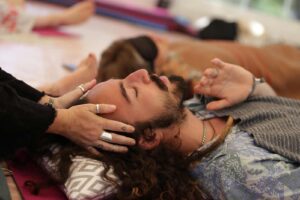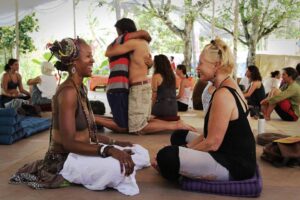“No one ever died while breathing.” Anthony Abbagnano’s words are only somewhat comforting, as I settle down on my girlfriend’s yoga mat for an hour of hyperventilation.
Last night I spent the evening with about a hundred other yoga-matted breathers in the vast domed sanctuary of the Round Chapel in Clapton. The event was called Psychedelic Breathwork, and jointly organised by the excellent Psychedelic Society and Anthony’s organisation Alchemy of Breath. I had no idea what to expect – but at least now I could be optimistic that death would play no part in it.
Anthony wears the loose cotton fabrics associated with serenity, topped off with just the sort of silvery mane and air of self-possession you’d expect to see in a man who breathes a lot. He starts the session by helping us warm up our voices (for reasons that soon become apparent – breathwork involves a lot of grunting). The domed nave resonates with bass and treble notes as we each find our place in the human score.
We should breathe in through the mouth, Anthony says, because it draws more air than the nose and the slight unfamiliarity helps keep us conscious of the process. “Think of that inhale as the first you took as a baby,” he says. Each out breath should be as our final breath, when we expire: death.
We have a practice round, all together on our mats. The breath fills our belly and chest, we fill up completely, every cell in our body. My mouth hangs open: in and out, in and out. Inspiration and expiration are seemlessly connected; with no pause between inhale and exhale.
Anthony warns us to expect dryness in the mouth, of course – but also the disturbingly common phenomenon where your hand turns into a claw. It sounds terrifying, but Anthony explains it’s simply a product of a change in the balance of oxygen and carbon dioxide in the body.
But rather than worrying about the science, we’re encouraged to attend to such emotions filed in our “body archive” and bring them to “the altar of our breath”. Whatever spasm that riffles through our bodies is an invitation to listen. Involuntary movements, we’re told, are the discharge of energy. Indeed, they are “one of the most significant signs of deep trauma release” according to Anthony. Let whatever happens, happen.
So, after tucking myself into a blanket and resting my head on my notebook-pillow, I begin. The musicians strike up a beat on drums and guitar, and Anthony instructs us in the first breaths.
What happened next was beyond my comprehension. As another breather said afterwards, “I wasn’t expecting to be taken on such a journey.”
Eyes closed, I inhale, I exhale, I inspire, I expire. My toes and fingers tingle. My mouth goes dry, and full of saliva too. My legs and arms flinch and shake. The vibrations in the room around me carry me off. My hands grow numb.
Then I feel a pain in my wrist. I open my eyes in astonishment: my hands are claws, fingers twisted back, curled into the palm, rigid at the joints. I try to move them, but it only hurts more to work against whatever energy is in control. Ten minutes pass: is this the end of my writing career?
I close my eyes again and concentrate on the breath, making sure to go as deep as I can, keeping inspiration and expiration as tightly connected as possible. Little by little, the left hand softens and returns, followed some time after by the right – although some pain in the wrist lingers.
I feel oddly invogorated by my brush with paralysis. Perhaps because Anthony had specifically warned this might happen: the method is working – whatever that might mean.
I breathe more deeply, sucking all the air of the dome into the depths of my belly. The energy or oxygen ripples through my limbs and I start to play around. I fling my arms to the air and feel the numbness spark out of my fingertips. I beat my feet on the yoga mat and shudder to the drum vibration.
I run my hands over my hair – I run my hands over my hair – I bury my hands in my hair! It’s like gel or jelly, like the strands and stems of a succulent plant, like water-filled balloons – like no hair I’d ever touched before! I laugh like a baby at the joy of texture.
I grow hot and feel the sweat on my back sticking to the yoga mat. I grow cold and feel the shivers of ice creeping into my toes and nose. I keep on breathing, in and out. Beastial grunts, moans and whimpers – even screams – slip out unbidden, from me and all those around me in the hall.
Then I sense the presence of a woman, kneeling over me. She lightly places a hand on my chest, followed by a hand on my forehead. There they rest with frail warmth, and in the connection I shudder with a rising emotion of I don’t know what. Something between the cloudburst of ecstasy and a heartrending loss.
As I hyperventilate, my breath starts to skitter away, involuntary sobs choke out from where I know not. The woman taps lightly on my chest – tap, tap, tap. “Breathe into the feeling,” she softly says. I breathe into the feeling – wherever that was. The sobs come harder and faster and my eyes tickle with tears.
My chest, arms and legs are bucking on the floor – at some point I knock over my water bottle. I beg myself to cry full tears and at that moment the woman whispers, “What is it that you can let go with your out breath?”
What is it, what is it, what is it? A carousel of images and scenes flicker through my brain – what is it, what is it, what is it that I can let go?
I HAVE NO IDEA!
With a final shudder, I sneeze three times. Someone on the next mat blesses me. I really want a felafel. Ten minutes later, I peep my eyes open, but the woman is gone. I’m exhausted, but proud that my body has responded so strongly. Then I’m just exhausted, swallowing back the thick film of breath that’s caught in my throat.
It’s time to end this breathwork. Anthony hears my silent prayer and calls down the musicians, guiding us back to our normal nose-breath.
We rest and gather in a huddle around the dais for a debrief.
“I wasn’t expecting to be taken on such a journey.”
Anthony told us to take care over the next few days, and to check in with ourselves to see if anything changed. Well, this morning I woke up with a chill and haven’t stopped sneezing all day. I’m sure Anthony would say that this is bad energy leaving my body – and, you know what? Science or no science, I don’t think he’d be wrong. I’ve been on the cusp of illness for a week or so: it’s time for this cold to break.
Oh, and I think I found the answer to the woman’s question. It’s not that I need to let go of anything in particular; I need to let go in general. That carousel of images were all things that I hold perhaps too tightly, too earnestly, too frantically. The lesson I’m taking is to loosen up and enjoy what I have, instead of crushing it in my clawlike grip.
Was this breathwork psychedelic? Perhaps not in the sense that most people would associate with psychedelic experience – there were no mind-altering “drugs” besides the oxygen freely available in the air. But perhaps the experience was psychedelic in the etymological sense of making the soul manifest. I certainly accessed an altered state of consciousness and feel like I emerged with a greater understanding of myself and soul.
A most intriguing (and legal) avenue has opened for exploration.
After posting this on Reddit, I expanded my impressions on the relationship between breathwork and the psychedelic, based purely on my experience.
I’m not an expert in breathwork after just one session, but I know people who are and they would say that the experience can be comparable to classic psychedelic substance use. But it takes a lot of practice.
For me, breathing led to a very legal altered state of consciousness and I think that’s valuable (at least where I live!). I also appreciated the level of control I had. When I take a psychedelic, I’m no longer really able to control the depth of experience – sometimes not for the next 14 hours. With the breathing, I could go deeper or bring myself back to the surface at will.
I didn’t get any visuals, but other people there did – lights and patterns seemed to be pretty common. I didn’t speak to anyone who had the type of involved, immersive hallucinations you get so easily with classic psychedelics. But I’ve heard it’s possible – although whether I’m prepared to put in the work is another question.
Breathwork, at least for me, was reminiscent of the very peak of psychedelic experience when your emotions are very close to the surface and you feel like you can examine them and perhaps learn something.
The differences were:
- Duration: the peak of breathing only lasted a few minutes, whereas the peak of a mushroom trip, say, can last hours.
- Intensity: the breathing peak (for me: this was, remember, my first time) felt quite fragile, like it could evaporate any moment. Mushrooms just blast away your defences by comparison. This is either a good or bad thing, depending!
- Control, as I mentioned before.
To those sceptical of the power of breathwork (as I was before I started exploring), I would say: try it once. You’ve nothing to lose but your doubts.
David Charles is a conscious media writer and meditation blogger. You can find more of his work here.

[vc_facebook type=”standard”]






